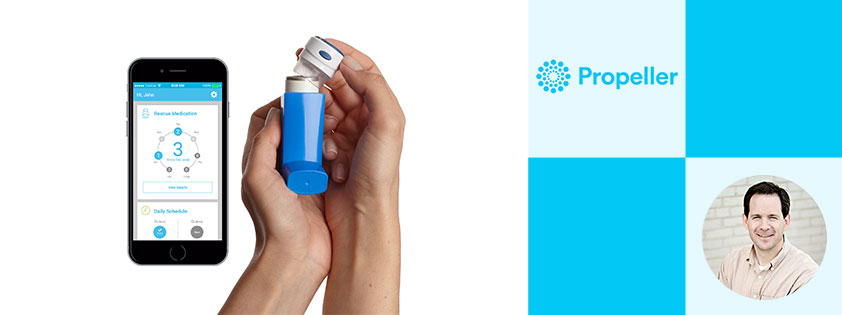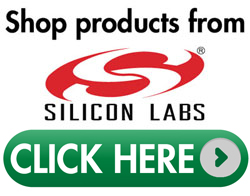- Home
- Symmetry Blog
- From Silicon Labs: Breathing Easy with IoT Hero Propeller Health
From Silicon Labs: Breathing Easy with IoT Hero Propeller Health
About Lance Looper

Tell us about your core offering.
Propeller is the leading digital platform to help people better manage respiratory conditions through sensors, mobile interfaces, and other services. The main conditions being asthma and COPD. Ultimately, we’re helping reduce the cost of care while delivering better quality of life for patients because we’re helping them remember when to take their medications and learn what their triggers are.
How did you arrive at helping people with these particular conditions? Healthcare is obviously a vast space, and we’d love to know how you landed where you did.
My cofounder and the CEO of the business today is David Van Sickle. David is an asthma epidemiologist; he’s been studying asthma his whole career. David was always puzzled by the lack of data he faced. And just organically during a medical fellowship at the University of Wisconsin, he started doing research on instrumenting inhaled medications and how that could become the method for data collection.
In 2010, David and I met through the third cofounder, Mark Gehring, and began exploring commercializing the work David started on campus. That was the birth of Propeller Health. That was the core: instrumenting inhaled medications to provide more insight back to patients so that they could understand the triggers that were causing some of their worst symptoms.
And by triggers, you mean helping patients identify maybe the times of day, or maybe even the locations or conditions where distress could be activated?
Exactly. What people should know is that there are very effective drugs on the market for treating both asthma and COPD. But what has been missing is more insight into the moments when people begin to be symptomatic. Our mission is to close the gap between those moments and effective treatment, to provide the insight the patient needs right when they need it.
We want to understand the environmental triggers, even specific locations that might be impacting your symptoms. The times of day, days of the week, that sort of thing. There’s some more outward-looking forecasting work as well. Taking into account all your prior history, our solution also monitors the forecast for air quality, pollen, and other weather conditions. Basically we want to give people a personalized forecast for the next week.
So tell us how does your solution work exactly. What’s going on under the hood?
Sure. It’s very straightforward. Users just attach our device directly to their inhaler after sign-up, and we take it from here. We describe ourselves as a “hardware-enabled software company.” Most of the real magic of the system are the analytics and insights that we can find and put together, based on your data and all of the complementary data that’s based on location, environmental factors, and other sensors.
But the secret sauce of all of that are the sensors themselves for several reasons. Mainly because if you can't collect that data passively, it’s really hard to get the analytics engine to work effectively. I think a lot of people peg us as a sensor company. We really consider ourselves a software company that is enabled by this really great, small, low-power piece of hardware that makes it easy for data collection.
Having the piece of electronics on the medication creates so many new opportunities. For example, when we instrument meds that users are supposed to take every day, we can use audible reminders on that device to help them remember when to take them. So we’ll push your personal schedule when you’re supposed to take your meds, so 9:00 a.m. and 9:00 p.m. And that schedule will persist on the sensor and give you a little chime when it's time to take your meds, if you haven't taken them already. Using accelerometers on the device, we can start to measure whether or not the medication is being used correctly, if it’s in the right orientation when the medication is dispensed. You can put microphones on it to listen for breath sounds and understand whether or not they have adequately inhaled the medication correctly. So what started out as this nice, clever data collection mechanism has evolved into a service that can provide feedback directly to the user in other ways.
How would you say your solution has evolved since 2010 when you started out?
Well, a big change is that we’ve tackled more in respiratory. We started off with only asthma, and in 2014 we expanded the platform to also include COPD. It’s a very different population to serve, since it’s a chronic condition that’s much harder to treat and the patient pool is typically the elderly.
Broadly speaking though, I would say our evolution mirrors most startups, where you start to understand the types of features that patients are interested in, and the types of insights that people are interested in, and you’re evolving constantly. Over time we’ve become a much more passive solution. We don’t expect patients to report in a lot or be bothered unnecessarily. We try to limit outreach to those moments when there’s something actionable or there’s an important new insight. We don’t want to constantly remind them they’re having to maintain a chronic condition. We want to help in a meaningful, nonintrusive way that simplifies their lives and improves their overall quality of life.
What design challenges have you faced during this evolution?
In addition to wanting to make the solution very passive for consumers, three other things come to mind. We wanted to make sure we had a long battery life. Early on, we were all happy because we got a 30-day charge, but then we saw people were not in the habit of charging things every 30 days. Low energy technology made that problem pretty much go away.
Secondly, early on we struggled with simple stuff like attachment. There are lots of different delivery devices, and how do you attach to all of them and make that simple? We've had a lot of innovation on the enclosure just with simple attachment systems. Lastly, pairing has always been difficult, especially in the iOS ecosystem. So we actually took a path of eliminating pairing from our sensors, and instead rely on a whitelisting technique inside of our apps.
Are you working directly with pharmaceutical companies?
We do. The respiratory pharma companies recognize Propeller Health as a complimentary digital solution working alongside the drugs, ultimately rendering them even more effective by helping optimize when people take them. I think they appreciate we’ve created an easy system that helps patients remember to take their general daily dose and then provides insights for when they’re using their reliever medications.
What Silicon Labs’ product are you using at Propeller? And why did you select it?
A big, ongoing design factor for us is overall cost of goods. That’s because we sell into a market that’s very price sensitive. Of course, you also want any part you use to do the job right.
We felt the Blue Gecko BGM121 Bluetooth Smart SiP module was the perfect marriage of good value and functionality. The beauty of it for us is that it encapsulated a microprocessor along with all of the BLE functionality. So we could drop a part, reducing the overall footprint. We also decided to use Silicon Labs again with another device coming out this fall as well. In that case, it’s letting us actually go from two boards down to one and really simplify design again.
Where do you see the collective IoT heading in the next 5–8 years in your opinion?
What comes to mind is actually what I’m hopeful for. I’m hopeful that the world takes advantage of IoT in a very passive way. And what I mean by that is, using it to automate more and just stay out in front of things, rather than giving all of us some new piece of technology or a new app to tinker with just because we can. So in a nutshell, helpful and unobtrusive. Not just more technology for technology’s sake.
Contact Symmetry Electronics at 866-506-8829, email us or start a live chat and we'll be glad to help you with your projects!

